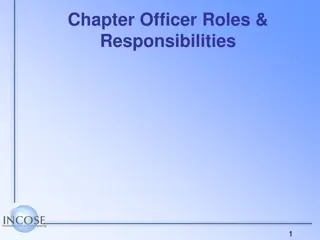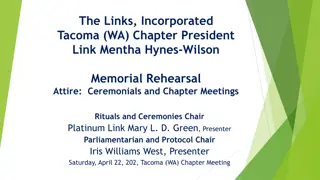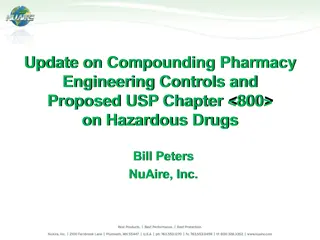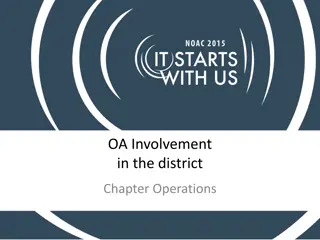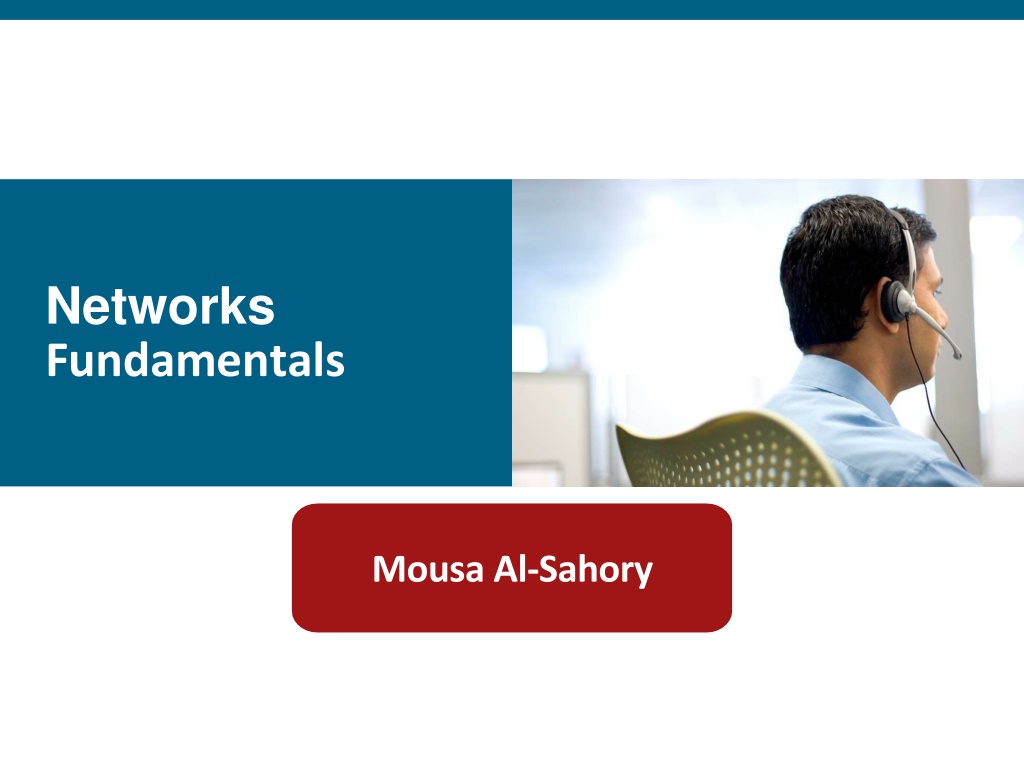
Understanding OSI vs TCP/IP Models in Networking Fundamentals
Explore the key differences between the OSI and TCP/IP models in networking fundamentals. Learn about the layered system, functions of each layer, and the importance of a structured approach in data communications. Enhance your understanding of protocols, data units, and encapsulation for efficient network design and maintenance.
Download Presentation

Please find below an Image/Link to download the presentation.
The content on the website is provided AS IS for your information and personal use only. It may not be sold, licensed, or shared on other websites without obtaining consent from the author. Download presentation by click this link. If you encounter any issues during the download, it is possible that the publisher has removed the file from their server.
E N D
Presentation Transcript
Networks Fundamentals Mousa Al-Sahory
Chapter 5 OSI vs TCP/IP OSI Layers
Network Fundamentals OSI vs TCP/IP
OSI model vs TCP/IP model The Open Systems Interconnection (OSI) model is a reference tool for understanding data communications between any two networked systems. TCP/IP are two protocols of this model. TCP stands for Transmission Control Protocol and IP stands forInternet Protocol. The OSI model consists of 7 architectural layers whereasthe TCP/IP only has 4layers. OSI is a reference model and TCP/IP is an implementationof OSI model. The OSI model however is a "generic,protocol-independent standard.
Layers with TCP/IP and OSI Model Why do we need layeredsystem 1. Reduces complexity (design, maintenance, troubleshooting) 2. Allows to use different media and protocols 3. Allows standardization (multi-vendor) 4. Fastens evolution (for example Ethernet)
OSI Reference Model Layers with TCP/IP and OSI Model Layer Function Data unit 7. Application Network process to application 6. Presentation Data representation and encryption Data 5. Session Host-to-host communication 4. Transport End-to-end connections and reliability Segment 3. Network Path determination and logical addressing Packet 2. Data Link Physical addressing Frame 1. Physical Media, signal and binary transmission Bit
Layers with TCP/IP and OSI Model Protocol data units (PDU) andencapsulation
Layer 1 PhysicalLayer 13
Physical Layer Protocols & Services PhysicalLayer is responsiblefor transmittingrow bit stream overthe physicalcable. Specifieselectrical,mechanicalrequirementsrequiredfor maintainingthe physicallink. PDU atphysicallayeris (bits). Thenearest layerto themedia. Functions: o Data encoding o Transmissiontechnique(modes) Simplex,halfduplexor fullduplex o Physical mediumtransmission o Modulation o Multiplexing :is a way of sending multiple signals or streams of information over a communications link at the same time in the form of a single, complex signal. o Bit synchronization o Manage physicalconnection o Bit ratecontrol o Line configuration Point-to-point,multipointorpoint-to-multipoint o Physical topology bus, ring, mesh or starnetwork Concernedaboutthe mediumtypes Copper,FiberOptics, Wireless etc
Physical Layer Signaling and Encoding Examples of encodingtechniques
Layer 2 Data Link Layer 19
Data Link Layer Accessing the Media Data link layer is responsible to provide an error-free transmission of information between two end stations. Functions: o Link establishment and termination o Frame traffic control o Physical addressing (MAC addressing) o Frame sequencing through the use of FCS (Frame Check Sequence) o Error Detection through the use of CRC (Cyclic Redundancycheck)
Data Link Layer Accessing the Media PDU at data link layer is (frame) Layer 2 switching happens at data link layer. Encapsulation of network layer data packets into frames Error Control Error Detection Error Correction Retransmission Flow Control
Data Link Layer Accessing the Media Data Link layer links the software and hardware layers
Data Link Layer Accessing the Media Data Link layer protocols are required to control mediaaccess 23
MAC Multiple Access Techniques Fixedassignment o Partitionchannelso each node getsa sliceof the bandwidth Channel Based. o Essentiallycircuitswitching thusinefficient o Protocol examples: TDMA,FDMA,CDMA(all usedin wireless/cellular environments 3G/4G/WiMAX/Blutooth) Contention-based o Nodescontendsequallyfor bandwidthandrecover fromcollisions o Protocol examples: CSMA/CD (usedinEthernet/IEEE802.3) CSMA/CA (usedinIEEE802.11/WiFi WLANs) The AlohaProtocol Token-based orreservation-based o Taketurnsusingthe channel o Protocol examples: Tokenbus(IEEE802.4) Tokenring(IEEE802.5) Tokenpassing(used inFDDI)
IEEE Standards IEEE 802.1: Standards related to network management. IEEE802.2: It defines Logical Link Control(LLC),which is the upper sub-layer of the data link layer of the OSIModel. IEEE 802.3: Defines the MAC layer for bus networks thatuse CSMA/CD. This is the basis of the Ethernetstandard. IEEE 802.4: Defines the MAC layer for bus networks thatuse a token-passing mechanism (token busnetworks). IEEE 802.5: Defines the MAC layer for token-ringnetworks. IEEE 802.6: Standard for Metropolitan Area Networks (MANs) IEEE 802.11: standard for Wireless LAN (WLAN) & Mesh (Wi- Fi certification) IEEE 802.16: standard for WiMAX
Ethernet Most popular packet-switched LANtechnology LAN standards define MAC and physical layerconnectivity o IEEE 802.3 (CSMA/CD - Ethernet) standard for 10Mbps o IEEE 802.3u standard for 100Mbps Ethernet Fast Ethernet o IEEE 802.3z standard for 1,000Mbps Ethernet Gig Ethernet o IEEE 802.3ae standard for 10Gbps Ethernet CSMA/CD: Ethernet s Media Access Control (MAC)policy CS = carrier sense Send only if medium is idle MA = multiple access CD = collision detection Stop sending immediately if collision is detected
Ethernet Ethernet by definition is a broadcastprotocol o Any signal can be received by all hosts o Switching enables individual hosts to communicate Network layer packets are transmitted over an Ethernet by encapsulating Frame Header Format
Ethernet Preamble is a sequence of 7 bytes, each setto 10101010 Used to synchronize receiver before actual data is sent MAC addresses Type field is a de-multiplexing key used to which higher level protocol the frame should be delivered to determine Body can contain up to 1500 bytes ofdata
MAC Address Unique, 48-bit unicast address assigned to each adapter(12 in Hex) Physicaladdress Each manufacturer gets their own addressrange Cant be changed broadcast: all 1s multicast: first bit is1
Cyclic Redundancy Check (CRC) Used for error detection. CRC has 2 methods: 1. Division method: Data is divided by a random number. The random number is placed in the first flag and the remainder of the division in the second flag, when data is received at the destination, it is divided by the random number in the first flag and the remainder should be the same as the one in the second flag. 2. Parity check: number of 1 s in the data is counted, if it is even a Zero is placed at the flag, and if it is odd a 1 is placed at the flag. At the destination, the number of 1 s in the received data is compared to the flag. A problem might occur if two 1 s are lost, then the parity check won t work, that is why both of the methods parity check and division method are usedtogether.
Frame Check Sequence(FCS) Each frame is given (assigned) a certainnumber. If frames arrives out of order, the frame sequencing number is used to rearrange the frames in the correct order. If an error is detected within a frame (corrupted), the frame number is used to inform the transport layer to retransmit the corruptedframe.
Collision Domain Collision is the effect of two nodes sending transmissions simultaneously in Ethernet. When they meet on thephysical media, the frames from each node collide and are damaged. Collision Domain is the network area in Ethernet over which frames that have collided will bedetected. Collisions are propagated by hubs andrepeaters Collisions are Not propagated by switches, routers,or bridges
Collision Domain A collision domain is the segment where devices must compete to communicate. o All ports of a hub belong to the same collision domain. o Every port of a switch is a collision domain on its own. o A switch break the segment into smaller collision domains, easing device competition.
Broadcast Domain A group of devices receiving broadcast frames initiatingfrom any device within thegroup Routers do not forward broadcast frames, broadcast domains are not forwarded from one broadcast to another.
Broadcast Domain A broadcast domain is the extend of the network where a broadcast frame can be heard. o Switches forward broadcast frames to all ports; therefore, switches do not break broadcast domains. o All ports of a switch, with its default configuration, belong to the same broadcast domain. o If two or more switches are connected, broadcasts are forwarded to all ports of all switches, except for the port that originally received the broadcast.

